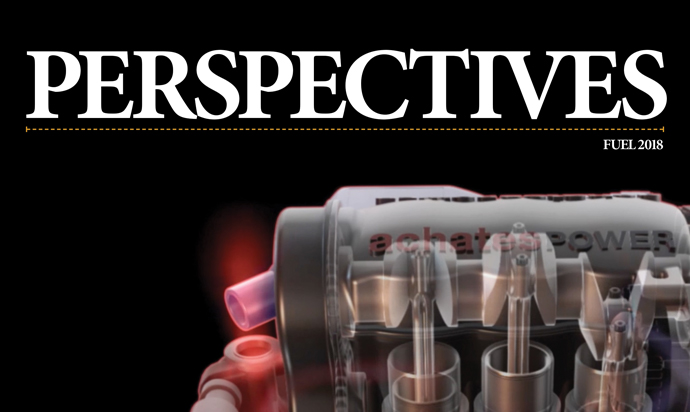Canada is driving toward a lower emissions future, but we risk paying a premium to do it if we don’t use all of the available lanes to get there, and we need to pay more attention to the speed limit. That’s the general message throughout Canadian Fuels’ new publication, Perspectives. “This is a decades-long transition; it’s not an immediate one”, says Peter Boag, President and CEO of Canadian Fuels. During that transition he explains, internal combustion engine and vehicle technology is a fast lane to cost-effective emissions reductions.
Boag says there is no doubt a transition to alternate vehicle technologies is underway. The questions are around the pace, cost, and effectiveness of those options. Boag says three basic questions must be explored if we are to achieve lower emissions:
- How much can technology accomplish, and how quickly?
- What will it cost, and can Canadians afford it?
- How much are Canadians willing to change their behaviour to meet reduction targets?
The best option is under our noses
While battery and electric vehicle technology is improving, and more models are entering the market every year, improvements are also occurring in the internal combustion engine (ICE) to significantly reduce emissions while maintaining their long-standing dependability, explains Boag.
Work by prominent institutions point to the same trend. A 2015 report from the Massachusetts Institute of Technology (MIT) indicates that improvements in mainstream technologies offer the best opportunity for near-term reductions in GHGs. Those improvements can be seen in ICEs, transmissions, and in-vehicle technology, such as weight reduction and aerodynamics.
According to the report, such improvements will provide the largest reductions to fuel consumption and GHG emissions for the next 20 years or more.
Additionally, the U.S. Environmental Protection Agency (EPA) noted this year that auto manufacturers have been developing and adopting fuel economy technologies at unprecedented rates; in fact, the technologies will allow automakers to meet ever-stricter fuel efficiency and emissions standards into 2025 at lower costs than predicted.
The question of cost
“Lower emissions will come at a cost”, says Boag. While accurate figures are hard to find, the Parliamentary Budget Office estimated in April 2016 that reaching Canada’s 30 per cent reduction target by 2030 would cost one to three per cent of GDP, or $600 to $1,900 for every citizen.
The Conference Board of Canada estimates that carbon pricing policies will increase consumer bills by about $1,200 per family by 2025.
“Governments really need to do a better job of understanding and communicating the costs of various options, and put a priority on options that deliver emissions reductions at the lowest possible cost," said Boag.
The consumer consideration
Often lost in the emissions reduction conversation, is the consumer. This is a concern, explains Boag, because consumers are a driving-force of the economy and will ultimately ‘foot the bill’ to reduce emissions. Additionally, he says, “it’s consumer behaviour that will really drive down emissions”.
“As much as Canadians say they want action on climate change, they are conflicted,” explains Boag. “There is a threshold at which they’re prepared to do that.”
The behaviour threshold is about cost, value and quality of life.
“Canadians have certain expectations with respect to transportation, particularly when they look at their own transportation and their vehicles,” said Boag. “They want them to deliver the kind of performance they’ve come to expect.” It’s similar to the electronics business, he explains. People don’t want to buy something that costs more and delivers less performance. They want to buy something that costs less and delivers more performance. And they still want to have choice.
“Transportation is so embedded in our daily lives,” Boag said. “It’s not just moving people around. It’s also about moving goods around. Goods movement is at the heart of economy. We don’t want to take actions that will compromise our abilities to move goods to market,” Boag said. “We need to be careful about the choices we make, and not inadvertently impede our mobility. There is a limit to the pace of change, beyond which we could do serious harm to the economy and our standard of living.”
Additionally, explains Boag, consumer behaviour needs to include efficient behaviour. There are so many resources to help drivers learn efficient driving techniques, make wise vehicle purchases, and incorporate lower emissions alternatives to driving, such as public transit.
What’s the solution?
There is more than one way to significantly reduce emissions at a reasonable cost, advises Boag. In fact, a smart way to reduce GHG emissions is to look at the three-lane approach of technology, efficiency and development:
- Pursue continuous improvements to ICE engine and vehicle technology.
- Conserve energy by operating vehicles and fleets more efficiently.
- Shift over time to alternative energy sources, as they become more reliable, cost-effective and available.
“Some people think in 10 years we’ll all be driving electric vehicles, but we’re simply not on pace to do that,” said Peter Boag. Transformative technologies are coming, he says, but the pace of development and adoption is relatively slow. Meanwhile, our economy — and we — must keep moving.
Learn more about the future of transportation fuels and the transition to a cleaner environment in Perspectives.

